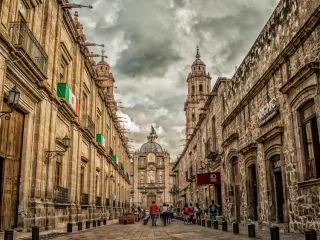Featured Posts
- News
Latest News: Robberies, Runways & Rising Tensions
The latest news and trends from around the world
- Business
The Beauty of Starting a Business Abroad
A practical guide to launching, scaling, and succeeding internationally
- Costa Rica
Your Guide for a Smooth Transition Moving to Costa Rica
Everything you need to know before relocating to Costa Rica
- Interviews
Inside the Life of a Solo Mother Traveling the World
How one woman turned single motherhood into a journey of freedom, purpose, and discovery
- Field Notes
Living Between Continents, Cultures, and Contradictions
What it means to grow up between worlds—and to belong to all of them
- Plan B
How to Legally Pay Less Tax Abroad
Smart planning, not secrecy, is the real offshore advantage.
- Field Notes
Abkhazia: Secrets of the Soviet Riviera
A Black Sea relic caught between past and politics
Plan B
All the information you need to make the move overseas
- Plan B
Belize Is Emerging as a Digital Gateway for Global Investors
As President of Caye International Bank, one of Belize’s leading international financial institutions, I have witnessed firsthand the transformative power of technology within our nation.…
- Plan B
How to Legally Pay Less Tax Abroad
In the last decade, taxation has become one of the defining forces behind global mobility. Governments are tightening revenue systems while entrepreneurs, remote workers, and retirees quietly…
- Your Escape Plan
Why More Investors Are Buying Homes Offshore
For decades, property ownership followed a familiar path: buy a family home, build equity, maybe add a vacation place if fortune allowed. But in a world of inflation, volatile markets, and…
- Canada
Nice Places to Live in Canada: Best Cities and Lifestyle Insights
Introduction When you start wondering about “what’s a nice place in Canada to live?”, you’re really asking something bigger than real estate. You’re picturing a place that feels right when the…
Sign up for the EA Newsletter
Get important news delivered directly to your inbox and stay connected!
Global Roundup
Trending Posts
- Field Notes
Living Between Continents, Cultures, and Contradictions
What it means to grow up between worlds—and to belong to all of them
- Plan B
How to Legally Pay Less Tax Abroad
Smart planning, not secrecy, is the real offshore advantage.
- Plan B
Belize Is Emerging as a Digital Gateway for Global Investors
Harnessing innovation to drive economic transformation
- Business
The Beauty of Starting a Business Abroad
A practical guide to launching, scaling, and succeeding internationally
- Mexico
7 Best Cities to Live in Mexico for Safety, Cost, and Lifestyle
Explore where to find the best mix of safety, comfort, and opportunity.
- Morocco
The Hottest New Expat Destination in Morocco
As Morocco prepares for the 2030 World Cup, its coastal expat destinations are evolving fast
- Interviews
Inside the Life of a Solo Mother Traveling the World
How one woman turned single motherhood into a journey of freedom, purpose, and discovery
Interviews
Insightful Q&As with travelers and expats from around the globe
- Interviews
Inside the Life of a Solo Mother Traveling the World
For German native Sarah Noack, motherhood never meant standing still. Three years ago, she set out on a journey that would redefine both travel and parenthood—becoming a solo mother traveling…
- Interviews
Inside the World of Luxury Travel with Christina Tan
For Christina Tan, luxury has never been about surface shine. As one of the world’s most respected hospitality influencers and a Leica Ambassador, Christina has carved out a global platform…
- Interviews
The House We Rebuilt in Georgia
Some homes aren’t found on property sites—they’re found in memory. That was true for David Macharadze, a 43-year-old Brit whose Georgian surname was the only part of his heritage he’d carried…



































